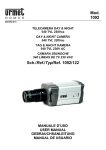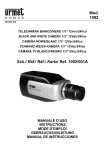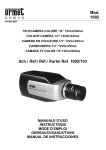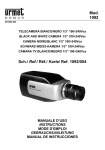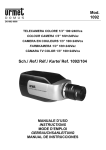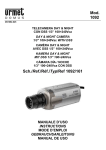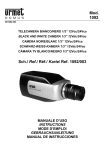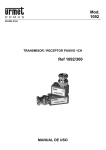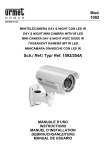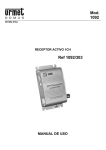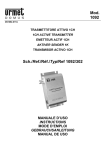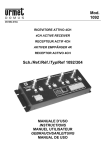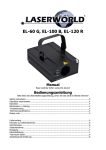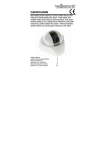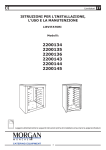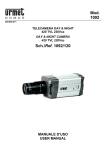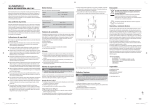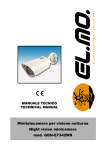Download Sch./Ref. 1092/120 Mod. 1092
Transcript
Mod. 1092 DS1092-071 TELECAMERA DAY & NIGHT 420 TVL 230Vca DAY & NIGHT CAMERA 420 TVL 230Vac TAG&NACHT KAMERA 420 TVL 230V AC Sch./Ref. 1092/120 MANUALE D’USO USER MANUAL GEBRAUCHSANLEITUNG ITALIANO PRECAUZIONI D’USO • • • • • • • • Assicurarsi dell’integrità dell’apparecchio dopo averlo tolto dall’imballo. Prima di effettuare qualsiasi operazione di pulizia o di manutenzione disinserire l’apparecchio dalla rete di alimentazione elettrica. Non usare prodotti spray per la pulizia dell’apparecchio. Controllare che la temperatura d’esercizio sia nei limiti indicati e che l’ambiente non sia particolarmente umido. Non toccare la superficie del sensore della telecamera. Se questo dovesse essere accidentalmente toccato, dovrà essere pulito con un panno morbido inumidito con alcool. Evitare di puntare la telecamera contro il sole per non danneggiare il CCD. In caso di guasto e/o cattivo funzionamento togliere l’alimentazione tramite l’interruttore generale. Il dispositivo deve essere aperto soltanto da personale tecnico qualificato. Per le riparazioni rivolgersi solo ad un centro di assistenza tecnica autorizzato. CARATTERISTICHE TECNICHE Tipo di sensore: .............................................................................................................. CCD 1/3”Super HAD Sistema di scansione:......................................................... 2:1 interlacciato PAL - V:50 Hz – H:15.625 KHz Risoluzione orizzontale:..................................................................................................................... 420 linee Sincronizzazione: ..................................................................................................................................Interna Compatibilità ottica: .......................................................................................................... DC Drive / Manuale Controllo shutter: ............................................................................................1/50 ~ 1/100.000 sec (ON/OFF) Compensazione controluce: ........................................................................................ Selezionabile ON/OFF Bilanciamento del bianco: ........................................................................................................ AUTOMATICO Controllo del guadagno: .............................................................................................. Selezionabile ON/OFF Sensibilità minima:................................................................................................................................ 0.5 Lux Uscita video: ..............................................................................................Uscita composita 1 Vpp, 75 Ohm Attacco obiettivi: ............................................................................................................................... Tipo”CS” Rapporto S/R:..........................................................................................................................................48 dB Alimentazione: ............................................................................................................................. 100÷240 Vca Consumo: .................................................................................................................................................... 3W Temperatura di utilizzo: ...................................................................................................................... -10÷50°c Temperatura d’immagazzinamento: ................................................................................................... -20÷60°c Dimensioni (L x P x H):......................................................................................................... 117 x 71 x 66mm Peso: ...................................................................................................................................................... 438 gr eNota Bene Le caratteristiche tecniche possono essere soggette a variazione senza alcun preavviso. ACCESSORI A CORREDO • • • • Connettore AUTO-IRIS a 4 poli. Coperchio CCD. Piastrina per fissaggio staffa. Manuale d’uso. eNota Bene La composizione degli accessori a corredo può essere variata senza alcun preavviso. 2 DS1092-071 IDENTIFICAZIONE DELLE PARTI Fori di montaggio supporto staffa Supporto per montaggio staffa Regolazione di easy back-focus Coperchio CCD Connettore AUTO-IRIS Led di segnalazione accensione Uscita video Regolazione Level Connettore AUTO-IRIS Alimentazione 230Vca Dip Switch NORME D’INSTALLAZIONE • LA TELECAMERA DEVE ESSERE COLLEGATA A TERRA. I conduttori del cavo d’alimentazione di rete devono essere cablati secondo la seguenti colorazione: VERDE/GIALLO: ........................................... Terra BLU: .............................................................Neutro MARRONE:.....................................................Fase • • • • • Per ulteriori informazioni, consultare il “Manuale Tecnico Sistemi Televisivi a Circuito Chiuso” Urmet Domus. Evitare di puntare direttamente l’obiettivo contro il sole o contro luci intense, anche se la telecamera è spenta; il soggetto da riprendere non deve essere in controluce. La presenza di alcuni tipi di luce (ad esempio fluorescente colorata) può sfalsare i colori. E’opportuno prevedere a monte degli apparecchi un idoneo interruttore di sezionamento e di protezione. Prima di collegare l’apparecchio alla rete di alimentazione accertarsi che i dati di targa siano rispondenti a quelli della rete di distribuzione. Evitare di puntare la telecamera verso oggetti riflettenti. Per ulteriori informazioni, consultare il “Manuale Tecnico Sistemi Televisivi a Circuito Chiuso” Urmet Domus. DS1092-071 3 PRECAUZIONI PER L’INSTALLAZIONE • Non installare la telecamera in ambienti esposti alla pioggia o all'umidità. In questi casi utilizzare le apposite custodie. Quando si usa la telecamera in ambienti in cui l’illuminazione varia, è necessario prevedere l’uso di un obiettivo con AUTO-IRIS. Per prevenire il surriscaldamento del dispositivo, collocarlo in una posizione ben aerata. Per lo stesso motivo non deve essere installato vicino a fonti di calore come radiatori o condotti d’aria calda o in posizioni dove sia esposto direttamente all’irradiazione solare così come non deve essere installato in locali soggetti a eccessiva polvere, vibrazioni meccaniche o urti. Tenere in considerazione la temperatura di funzionamento dell’unità (-10°C÷+50°C) prima di scegliere il luogo per l’installazione. Non installare l’unità sopra un’altra apparecchiatura che emani calore. Non mettere in funzione il dispositivo immediatamente dopo il trasporto da un luogo freddo ad un luogo caldo e viceversa. Attendere mediamente tre ore: questo intervallo di tempo è necessario al dispositivo per adattarsi al nuovo ambiente (temperatura,umidità,ecc.). • • • • • DIMENSIONI (mm) Lato superiore Lato inferiore INSTALLAZIONE 1. 2. 3. 4. 5. 6. 7. Prima d’iniziare l’installazione, assicurarsi che tutte le unità da collegare non siano alimentate. Togliere il coperchio di protezione del CCD. Montare l’obiettivo sulla telecamera. Collegare il cavo al connettore AUTO-IRIS . Collegare l’uscita video all’utilizzatore previsto utilizzando un cavo coassiale da 75 Ohm omologato. Alimentare la telecamera. Effettuare le regolazioni necessarie (vedere il paragrafo successivo). CONNETTORE AUTO-IRIS Definizione PIN connettore Auto-Iris PIN 1 2 3 4 4 DC DAMP (-) DAMP (+) DRIVER (+) DRIVER (-) 1 3 2 4 DS1092-071 PROCEDURA DI MESSA A FUOCO PER OTTICHE AUTO-IRIS 1. 2. 3. 4. 5. 6. Posizionare il selettore ELC/ALC del dip-switch sulla posizione ELC (utilizzando lenti tipo Dc driver). Puntare la telecamera sul campo da riprendere assicurandosi che la luce sia sufficiente per la ripresa; ruotare il trimmer LEVEL sino ad ottenere un’immagine totalmente bianca. Questa procedura provoca la massima apertura del diaframma dell’obbiettivo con il minimo campo focale in modo da ottimizzare la messa a fuoco del punto desiderato. Posizionare il dip-switch sulla posizione ELC per ottenere l’immagine nuovamente visibile e correttamente contrastata. Effettuare la regolazione del fuoco se si usa una lente a ottica fissa. Se la lente è di tipo varifocal eseguire la regolazione di zoom e fuoco. Se le immagini non risultassero perfettamente a fuoco, agire sulla registrazione di Easy Back Focus; al termine della registrazione avvitare il perno di registrazione per non perdere la regolazione eseguita. Riposizionare il dip-switch sulla posizione ALC per ottenere nuovamente la visione delle immagini bianche o sature di bianco; regolare il trimmer LEVEL sino a ottenere la corretta luminosità dell’ immagine USO DI COMANDI E PREDISPOSIZIONI Led di segnalazione accensione Uscita video Regolazione Level Connettore AUTO-IRIS Alimentazione 230Vca Dip Switch Regolazione di easy back-focus DS1092-071 5 USO DEI DIP SWITCH Controllo automatico dell’esposizione (ELC-ALC) Per mezzo del commutatore ELC/ALC è possibile selezionare 2 tipi di obiettivi: • Obiettivi DC driver (senza amplificatore): posizionare il commutatore sulla posizione ALC. La velocità dell’otturatore elettronico viene automaticamente variata in funzione delle condizioni di illuminazione ambientale; nel caso che non si ottenga un’immagine chiara e pulita si può agire sulle regolazioni di LEVEL della telecamera. La velocità dell’otturatore elettronico rimane costante (1/50 di secondo). • Obiettivi MANUALI: posizionare il commutatore sulla posizione ELC. La velocità dell’otturatore elettronico varia automaticamente in funzione della luce (da 1/50 di secondo a 1/100.000 di secondo). Compensazione controluce (BLC-OFF) Un soggetto inquadrato con una forte luce proveniente da dietro solitamente appare scuro e poco visibile rispetto al resto dell’immagine. Per ovviare a questo inconveniente ed ottenere una buona compensazione, posizionare l’interruttore del dip-switch sulla posizione BLC. Modalità anti-sfarfallio (FLC-OFF) Uno sfarfallio sullo schermo può essere causato da una fonte luminosa fluorescente a 50 HZ. Per ridurre il fenomeno posizionare l’interruttore del dip-switch sulla posizione FLC. Controllo automatico del guadagno (AGC-OFF) Selezionando il dip-switch nella posizione AGC si aumenta l’amplificazione del segnale in condizioni di bassa luminosità ambientale permettendo di continuare ad avere una immagine più luminosa anche con bassa illuminazione. 6 DS1092-071 La telecamera 1092/120 è predisposta per il montaggio mediante staffa di supporto. • Fissare il supporto di fissaggio con le tre viti alla telecamera. • E’ possibile posizionare tale supporto su entrambi i lati della telecamera. Fori di montaggio supporto staffa • Fissare la base sul lato inferiore per il posizionamento a parete o sul lato superiore per il posizionamento a soffitto. PULIZIA DEL DISPOSITIVO • • • Usare un panno asciutto e strofinare leggermente per eliminare polvere o sporcizia. Nel caso la sporcizia non fosse eliminabile con un panno asciutto, compiere l’operazione con un panno inumidito di detergente neutro. Non usare liquidi volatili come benzina, alcool, solventi, ecc. o panni trattati chimicamente per pulire il dispositivo al fine di evitare deformazioni, deterioramenti o graffi nella finitura della superficie. DIAGNOSTICA PROBLEMI POSSIBILI CAUSE La tensione di rete non è compatibile con la minicamera Non appare nessuna immagine a monitor Verificare Non è stato collegato il cavo di alimentazione della minicamera Non è stato collegato il cavo video della minicamera La lente esterna della minicamera è sporca Le immagini sul monitor non sono nitide SOLUZIONI Non sono state regolate correttamente le impostazioni di messa a fuoco Eseguire i collegamenti Verificare Regolare Messa a Fuoco Il monitor non è correttamente regolato nelle impostazioni di Correggere Contrasto e Luminosità Nel caso in cui il problema riscontrato non fosse risolvibile seguendo le indicazioni della tabella sopra riportata, contattare un centro di assistenza tecnica autorizzato. DS1092-071 7 ENGLISH PRECAUTIONS • • • • • • • • Make sure that the device is intact after removing it from the package. Disconnect the device from the mains before cleaning or maintenance. Do not use spray products to clean the device. Check that the working temperature is within the indicated range and that the environment is not particularly humid. Do not touch the camera sensor surface. Clean the surface with a soft cloth and methylated spirit in the event of accidental contact. Do not point the camera towards the sun to prevent damaging the CCD. Disconnect power by means of the circuit breaker in the event of a failure and/or bad operation. The device can only be opened by qualified technical personnel. Exclusively contact an authorised service centre for repairs. TECHNICAL SPECIFICATIONS Type of sensor:............................................................................................................... CCD 1/3”Super HAD Scanning system: .............................................................. 2:1 interlaced - CCIR - V: 50 Hz - H: 15.625 kHz Horizontal resolution:........................................................................................................................ 420 lines Synchronisation: ...................................................................................................................................Internal Optics: ................................................................................................................................ DC Drive / Manual Shutter control: ...............................................................................................1/50 ~ 1/100.000 sec (ON/OFF) Back-lighting compensation:............................................................................................. Selectable ON/OFF White balancing: ..................................................................................................................................... AUTO Gain control: ..................................................................................................................... Selectable ON/OFF Minimum sensitivity: ............................................................................................................................. 0.5 Lux Video output: .............................................................................................Composite output 1Vpp, 75 Ohm Lens fitting: ..................................................................................................................................... ”CS” Type S/R ratio:..................................................................................................................................................48 dB Power: .................................................................................................................................................. 230Vac Consumption: .............................................................................................................................................. 3W Working temperature range:............................................................................................................... -10÷50°c Storage temperature range: ............................................................................................................... -20÷60°c Dimensions (W x D x H): ...................................................................................................... 117 x 71 x 66mm Weight: ................................................................................................................................................... 438 gr eImportant note: Product specifications may be subject to change without prior notice. ACCESSORIES PROVIDED • • • • 4 pole AUTO-IRIS connector. CCD cover. Stand for bracket mounting. User manual. eImportant note: Accessories may be changed without prior notice. 8 DS1092-071 ELEMENTS IDENTIFICATION Mounting holes for bracket support Stand for bracket mounting Easy back-focus adjustment CCD cover AUTO-IRIS connector Power-on led Video output Level adjustment AUTO-IRIS connector 230Vac power supply Dip Switch INSTALLATION SPECIFICATIONS • THE CCTV CAMERA MUST BE GROUNDED. The mains cables must be wired according to the following colour coding: GREEN/YELLOW: ......................................Ground BLUE:.......................................................... Neutral BROWN: ...................................................... Phase See Urmet Domus “Closed circuit TV technical installation manual” for further information. • Avoid pointing the lens directly towards the sun or intense sources of light also when the camera is off. The subject must not be backlit. • Some lighting systems (e.g. coloured fluorescent lights) may false the colours. • Arrange a suitable circuit breaker and fuse upstream of the devices. • Make sure that the rating plate data correspond to the power specifications before connecting the device to the mains. • Do not point the camera towards reflecting objects. See Urmet Domus “Closed circuit TV technical installation manual” for further information. DS1092-071 9 INSTALLATION PRECAUTIONS • Never install the CCTV camera where it is exposed to rain or moisture. In these cases, use the specific housings. When the CCTV camera is used in variable lighting conditions, an Auto-Iris lens must be used. To prevent device overheating, place it in a well aired position. For the same reason, the device must not be installed near heat sources as radiators or warm air ducts, in places where it is directly exposed to sun irradiation or in rooms with excessive dust accumulation, subject to mechanical vibrations or impacts. Consider the device operating temperature range (-10°C÷+50°C) before choosing the place for installation. Do not install the unit over another heating device. Do not power the device on immediately after moving it from a cold place to a warm one and vice versa. As a general rule, wait for three hours: the device needs this time to adapt to a new environment (temperature, humidity, etc.). • • • • • DIMENSIONS (mm) Upper side Lower side INSTALLATION 1 2 3 4 5 6 7 Make sure that no units are powered before starting the installation procedure. Remove the CCD cover. Fit the lens on the camera. Connect the wire to the AUTO-IRIS connector . Connect the CCTV camera to the other devices of the system using an approved 75 ohm coax cable. Power the mini camera. Make the adjustments required (see paragraph below) AUTO-IRIS PLUG Auto-Iris plug PIN definition PIN 1 2 3 4 10 DC DAMP (-) DAMP (+) DRIVER (+) DRIVER (-) 1 3 2 4 DS1092-071 FOCUSING PROCEDURE FOR AUTO-IRIS LENSES 1. 2. 3. 4. 5. 6. Set the dip-switch ELC/ALC selector to ELC position (using Dc driver lenses). Point the camera at the field to be shot and make sure light is sufficient for shooting; rotate the trimmer LEVEL until the image is totally white. This procedure causes the maximum f-stop aperture, with the minimum focus field, in order to optimize the focusing of the desired point. Set the dip-switch to ELC position to make the image visible again and with a right contrast. Perform focus adjustment if a fixed lens is used. If the lens is varifocal, adjust zoom and focus. If images focus is not perfect, adjust Easy Back Focus; after adjustment, screw the adjustment pin in order not to lose the adjustment just performed. Set again the dip-switch to ALC position to obtain again white or white saturated images; adjust the trimmer LEVEL until image brightness is correct. USING COMMANDS AND PRESETTINGS Power-on led Video output Level adjustment AUTO-IRIS connector 230Vac power supply Dip Switch Easy back-focus adjustment DS1092-071 11 DIP SWITCHES USE Exposure automatic control (ELC-ALC) 2 kinds of lenses can be chosen by means of ELC/ALC switch: • DC driver lenses (without amplifier); put the switch on position ALC. The electronic shutter speed is automatically changed according to environment lighting conditions; if the obtained image is not clear and sharp it is possible to change camera LEVEL adjustments. The electronic shutter speed is not affected (1/50 second). • MANUAL lenses: put the switch on ELC position. The electronic shutter speed automatically changes according to light (from 1/150 second to 1/100.000 second). Backlight compensation (BLC-OFF) An object with a strong light in the background usually appears dark and not so visible if compared with the rest of image. To solve this problem and obtain a good compensation, put the dip-switch on BLC position. The BLC function allows to solve this problem and obtain a good compensation. Anti-flicker mode (FLC-OFF) Flicker on the screen can be caused by a 50 HZ fluorescent light source. To reduce this effect, put the dipswitch on FLC position. Gain automatic control (AGC-OFF) Put the dip-switch in AGC position to increase the signal amplification under poor light environmental conditions, allowing to have a brighter image also under poor light conditions. The camera 1092/120 can be installed using a support bracket. • Fasten the fixing support to the camera with the three screws. • This support can be installed on both camera sides. Bracket support mounting holes • 12 Fix the base on the lower side for wall mounting or on the upper side for ceiling mounting. DS1092-071 CLEANING THE DEVICE • • • Rub delicately with a dry cloth to remove dust and dirt. Dip the cloth in neutral detergent if dirt cannot be eliminated with a dry cloth alone. Do not use volatile liquids (such as petrol, alcohol, solvents, etc.) or chemically treated clothes to clean the device to prevent deformation, deterioration or scratches to the paint finish. TROUBLESHOOTING PROBLEMS No image displayed on the screen POSSIBLE CAUSES The mains voltage is not Check compatible with the minicamera. The minicamera power supply cable has not been connected. The minicamera video cable has not been connected. Make the connections The minicamera external lens is dirty. Displayed images are not sharp enough. SOLUTIONS Focus settings are not correctly adjusted. Monitor contrast and brightness settings are not correctly adjusted. Check Adjust focus Modify If the problem can not be solved following the instructions in the table above, contact an authorized technical assistance. DS1092-071 13 DEUTSCH VORSICHTSMASSNAHMEN • • • • • • • Nach dem Auspacken des Gerätes muss sichergestellt werden, dass es sich in einwandfreiem Zustand befindet. Vor dem Ausführen jeglicher Reinigungs- oder Wartungsarbeiten, das Gerät vom Stromversorgungsnetz trennen. Für die Reinigung des Geräts keine Sprays verwenden. Wenn extern installiert, ist die Positionierung in einer geschützten Umgebung vorzuziehen, d.h., nicht in direktem Kontakt mit großen Witterungseinflüssen (Regenfälle oder erhöhte Temperaturen). Die Oberfläche des Sensors der Kamera nicht berühren. Sollte dieser versehentlich berührt werden, muss er mit einem weichen, mit Alkohol befeuchteten Tuch gereinigt werden. Bei Defekten und/oder mangelnder Funktionstüchtigkeit, die Versorgung über den Hauptschalter abschalten. Das Gerät darf nur von qualifiziertem technischem Personal geöffnet werden. Für Reparaturen wenden Sie sich bitte nur an ein autorisiertes Zentrum des technischen Kundendiensts. TECHNISCHE EIGENSCHAFTEN Sensorart: ....................................................................................................................... CCD 1/3”Super HAD Scannersystem:.............................................................. 2:1 Verflochten - CCIR - V: 50 Hz - H: 15.625 kHz Horizontale Auflösung: ................................................................................................................... 420 Linien Synchronisierung:....................................................................................................................................Intern Optik: ................................................................................................................................. DC Drive / Manuell Steuerung Shutter: ....................................................................................... 1/50 ~ 1/100.000 Sek. (ON/OFF) Gegenlicht-Kompensation: .............................................................................................Auswählbar ON/OFF Weißabgleich:......................................................................................................................................... AUTO Steuerung der Verstärkung: ...........................................................................................Auswählbar ON/OFF Mindest-Beleuchtungsstärke: ............................................................................................................... 0.5 Lux Videoausgang:........................................................................... Mehrteiliger Videoausgang 1Vpp, 75 Ohm Objektivbefestigung: ....................................................................................................................... ”CS” Type Verhältnis S/R:.........................................................................................................................................48 dB Versorgung: ........................................................................................................................................ 230V AC Verbrauch: ................................................................................................................................................... 3W Betriebstemperatur: .......................................................................................................................... -10÷50° C Lagertemperatur: .............................................................................................................................. -20÷60° C Abmessungen (B x L x T): .................................................................................................... 117 x 71 x 66mm Gewicht:................................................................................................................................................... 438 g eBeachten: Produkteigenschaften können ohne vorherige Ankündigung geändert werden. IN DER LIEFERUNG ENTHALTENS ZUBEHÖR • • • • 4 poliger AUTO-IRIS Verbinder. CCD Abdeckung Halterungsfuß mit drei Schrauben für Wand- oder Deckenhalter. Gebrauchsanleitung eBeachten: Zubehör kann ohne vorherige Ankündigung geändert werden. 14 DS1092-071 IDENTIFIZIERUNG DER TEILE Befestigung des Halterungsfußes Fuß für Befestigungshalter Einfache Schärfeeinstellung CCD Abdeckung AUTO-IRIS Verbinder LED Videoausgang LEVEL Einstellung AUTO-IRIS Anschluss 230V AC Versorgung Dip Switch INSTALLATION • DIE CCTV KAMERA MUSS GEERDET WERDEN. Die Versorgungsleitung muss wie folgt angeschlossen werden: GRÜN-GELB:.................................................. Erde BLAU: .......................................................Nullleiter BRAUN: ....................................................... Phase • • • • • Vermeiden Sie es, das Objektiv direkt gegen die Sonne oder intensive Lichteinstrahlung zu richten, auch bei ausgeschalteter Kamera. Der aufzunehmende Gegenstand darf sich nicht im Gegenlicht befinden. Einige Lichtarten (z.B. fluoreszierendes farbiges Licht) können die Farben verfälschen. Es ist von Vorteil dem Gerät einen geeigneten Trenn – und Schutzschalter vorzuschalten. Bevor das Gerät an das Versorgungsnetz angeschlossen wird, ist sicherzustellen, dass die Kenndaten denen des Verteilernetzes entsprechen. Die Kamera nicht auf reflektierende Objekte ausrichten. DS1092-071 15 INSTALLATIONSBESTIMMUNGEN • Die Kamera nicht in Regen oder Feuchtigkeit ausgesetzten Umgebungen installieren. In diesen Fällen die dafür vorgesehenen Gehäuse verwenden. Wird die Kamera in Umgebungen mit wechselndem Lichteinfall eingesetzt, muss die Verwendung mit AUTO-IRIS Objektiven vorgesehen werden. Zum Schutz der Überhitzung bitte das Gerät in gut klimatisierten Bereichen montieren. Das Gerät nicht in Umgebungen verwenden, in denen Rauch, Dampf, Staub oder starke Vibrationen vorhanden sind. Achten Sie auf die Betriebstemperatur (-10°C÷+50°C) des Gerätes, bevor Sie den geeigneten Ort der Installation auswählen. Installieren Sie das Gerät daher nicht in der Nähe von Wärmequellen. Gerät nicht unmittelbar nach dem Transport von einem kühlen an einen warmen Ort oder umgekehrt in Betrieb nehmen. Im Durchschnitt sind drei Stunden abzuwarten: dieser Zeitraum ist erforderlich, damit das Gerät sich an die neue Umgebung anpassen kann (Temperatur, Feuchtigkeit, etc.). • • • • • ABESSUNGEN (mm) Oben Unten INSTALLATION 1 2 3 4 5 6 7 Vor der Installation sicherstellen, dass alle anzuschließenden Einheiten von der Versorgung getrennt sind. Entfernen der CCD Abdeckung. Das Objektiv auf die Kamera montieren. Wenn vorhanden, den AUTO-IRIS Stecker des Objektivs mit der Kamera zu verbinden. Die Kamera an die anderen Vorrichtungen der Anlage anschließen, indem Sie ein geeignetes Koaxialkabel (z. B: RG59) mit 75 Ohm verwenden. Schalten Sie die Versorgungsspannung ein. Die notwendigen Einstellungen durchführen (siehe nachfolgender Abschnitt) AUTO-IRIS VERBINDER Definition Pin AUTO-IRIS Verbinder PIN 1 2 3 4 16 DC DAMP (-) DAMP (+) DRIVER (+) DRIVER (-) 1 3 2 4 DS1092-071 VORGANG DER SCHARFEINSTELLUNG MIT AUTO-IRIS OPTIKEN 1. 2. 3. 4. 5. 6. Den DIP-Switch ELC/ALC auf ELC positionieren (bei Einsatz von DC gesteuerten Objektiven). Ausrichtung der Kamera auf den gewünschten Bildausschnitt und dafür sorgen dass gute Lichtverhältnisse im gewünschten Bildausschnitt vorhanden sind; den LEVEL-Regler drehen, bis ein weißes Bild erscheint. Diese Prozedur bewirkt bei maximaler Öffnung der Blende mit einem minimalen Schärfefeld, eine optimale Einstellung des gewünschten Bildausschnitts. Den Dip-Switch auf die Position ELC stellen, um das Videobild wieder mit dem richtigen Kontrast anzuzeigen. Bei Objektiven mit fester Brennweite die Schärfe anpassen. Werden varifokale Objektive eingesetzt, den Zoom und die Schärfe regulieren . Ist die Bildschärfe nicht ausreichend kann über die einfache Schärfeeinstellung an der Seite der Kamera weiter reguliert werden; nach der Justierung sollte die Feststellschraube wieder festgeschraubt werden. Den Dip-Switch auf die Position ALC stellen um weiße oder weiß gesättigte Videobilder zu erhalten; den LEVEL-Regler so einstellen, bis die korrekte Bildhelligkeit erreicht ist. VERWENDUNG DER STEUERUNGEN UND VOREINSTELLUNGEN LED Videoausgang LEVEL Einstellung AUTO-IRIS Anschluss 230V AC Versorgung Dip Switch Einfache Schärfeeinstellung DS1092-071 17 DIP SWITCHE Steuerung der AUTO-IRIS (ELC-ALC) Mittels des Dip-Switches ELC/ALC ist es möglich, zwei Objektivtypen auszuwählen: • DC gesteuerte Objektive (ohne Verstärker); den Schalter auf die Position ALC Stellen. Die Geschwindigkeit des elektronischen Shutters passt sich automatisch den gegebenen Lichtverhältnissen an; sollte kein klares und sauberes Bild erzielt werden können die LEVELEinstellungen der Kamera verwendet werden. Der elektronische Shutter wird davon nicht beeinträchtigt (1/50 Sekunden). • Manuelle Objektive: den Schalter auf die Position. Die Geschwindigkeit des elektronischen Shutters passt sich automatisch den gegebenen Lichtverhältnissen an (von 1/150 Sekunde bis 1/100.000 Sekunde). Gegenlicht-Kompensation (BLC-OFF) Ein ausgewählter Gegenstand mit starkem, von hinten kommendem Licht erscheint normalerweise dunkel und im Vergleich zum Rest des Bildes schlecht sichtbar. Um diesem Problem abzuhelfen und einen guten Ausgleich zu erzielen, den Schalter BLC der Dip Switche auf Position BLC stellen. Anti-flicker mode (FLC-OFF) Ein Flackern auf dem Bildschirm kann durch floureszierendes Licht bei 50 Hz verursacht werden. Um dieses Phänomen zu verringern, den Schalter FLC der Dip Switche auf die Position FLC stellen. Automatische Steuerung der Verstärkung (AGC-OFF) Die Verwendung der automatischen Verstärkung (Schalter AGC der Dip-Switche auf Position AGC stellen) gestattet die Erhaltung eines klaren Bildes auch unter mittleren bis schlechten Lichtbedingungen der Umgebung. Die Kamera 1092/120 kann mit einem Halterungsfuß an Wand- oder Deckenhalterungen montiert werden. • Befestigen des Halterungsfußes mit den drei im Lieferumfang enthaltenen Schrauben. • Der Halterungsfuß kann beidseitig montiert werden. Befestigung des Halterungsfußes • 18 Montieren der Kamera mit der Unterseite bei einem Wandhalter und an der Oberseite bei einem Deckenhalter. DS1092-071 REINIGUNG DES GERÄTES • • Um Staub und Schmutz zu entfernen, Gerät mit einem trockenen Tuch abreiben. Sollte der Schmutz mit einem trockenen Tuch nicht zu entfernen sein, Gerät mit einem feuchten Lappen und Neutralreiniger abwischen. • Um Verformungen, Beschädigungen oder Kratzer im Lack zu verhindern, keine flüchtigen Flüssigkeiten wie Benzin, Alkohol, Lösungsmittel etc. oder chemisch behandelte Tücher zur Reinigung des Geräts verwenden. FEHLERSUCHE PROBLEM Es wird kein Bild am Monitor angezeigt Angezeigte Videobilder haben keine Tiefenschärfe. FEHLERURSACHE Die Spannungsversorgung ist nicht kompatibel zur Kamera. Die Spannungsversorgung ist nicht an der Kamera angeschlossen. Das Videokabel ist nicht an die Kamera angeschlossen. LÖSUNGEN Überprüfen und Messen der Versorgungsspannung Verbindungen herstellen Das Objekt an der Kamera ist verunreinigt. Überpüfen und gegebenenfalls Reinigen des Objektivs Die Fokus-Einstellung sind nicht korrekt eingestellt. Einstellen der Fokussierung Die Einstellungen der Helligkeit und des Kontrastes sind am Monitor nicht richtig eingestellt. Anpassen des Monitorbildes Sollte das anstehende Problem nicht behoben werden können, kontaktieren Sie bitte zur Hilfe einen autorisierten Kundenservice. DS1092-071 19 DS1092-071 Prodotto in Cina su specifica URMET Domus Made in China to URMET Domus specification FILIALI 20151 MILANO – V.Gallarate 218 Tel. 02.380.111.75 - Fax 02.380.111.80 00043 CIAMPINO (ROMA) V.L.Einaudi 17/19A Tel. 06.791.07.30 - Fax 06.791.48.97 80013 CASALNUOVO (NA) V.Nazionale delle Puglie 3 Tel. 081.193.661.20 - Fax 081.193.661.04 30030 VIGONOVO (VE) – V.del Lavoro 71 Tel. 049.738.63.00 r.a. - Fax 049.738.63.11 66020 S.GIOVANNI TEATINO (CH) – V.Nenni 17 loc. Sambuceto Tel. 085.44.64.851 Tel. 085.44.64.033 - Fax 085.44.61.862 SEDE 20 URMET DOMUS S.p.A. 10154 TORINO (ITALY) VIA BOLOGNA 188/C Telef. +39 011.24.00.000 (RIC.AUT.) Fax +39 011.24.00.300 - 323 Area Tecnica Servizio Clienti +39 011.23.39.810 http://www.urmetdomus.com e-mail: [email protected] DS1092-071




















